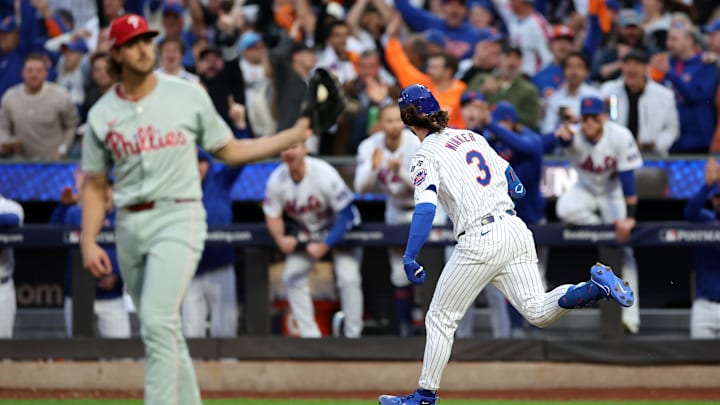The Philadelphia Phillies postseason ended before it even got started. Wednesday's 4-1 defeat at the hands of the New York Mets in Game 4 of the NLDS put a punctuation mark on a 2024 season marked by exceptional highs and devastating lows. For Phillies fans spoiled by watching the team make long playoff runs over the last two seasons, reality has now set in that this October is going to be a lot different.
There were a number of factors that collectively sunk the Phillies' title hopes this season. With the team now at day one of what will be a very long offseason, speculation of what the Phillies front office's plans are for 2025 and beyond is certain to dominate the news cycle. We'll save that for another time.
This year will go down as a tail of two seasons for a Phillies team that looked unstoppable from April to roughly around the All-Star break. It's probably fair to say that this was a team that peaked too early, and confidence from that early-season success clouded the judgment of everyone ranging from Dave Dombrowski to Rob Thomson to members of the coaching staff.
We should have seen the Phillies’ early playoff exit coming a mile away
That false sense of security played out to devastating effect as the offense stopped clicking for long stretches, reliable bullpen arms lost the plot, and the ball was repeatedly handed to a starting pitcher whose contract is rightfully in the discussion for being one of the worst free agent signings in team history. There were numerous clues that this team didn't have what it takes this season, and like the team itself, none of us watching at home wanted to believe it either.
Something stopped clicking for the Phillies after the team walked off an international flight following the team's return from splitting two games against the Mets during the London Series. If you want to chart the beginning of a concerning trend of injuries and inconsistent play, all signs point to this being the time period when the wheels started to fall off.
Let's start with the Phillies' record. From late March (three games) until the end of June, the team held a record of 55-29, tops in MLB and good for a healthy first-place lead in the NL East. July provided the first of many reality checks, with the team posting a losing record of 10-14, some of that could be blamed on injuries, but a pattern of poor decisions started to influence the results.
The Phillies produced a 15-13 record in August and a 15-11 showing in September. The team ultimately won the division with a 6.0-game lead over the Braves and Mets, but it was clear the Phillies left a lot of wins on the table in the second half of the season.
Bad decisions caught up to the Phillies post-All-Star break
That's when some of the questionable decisions started to influence the results. It had been clear since spring training that Taijuan Walker was not going to be a reliable starting pitcher this year. With a sharp drop in velocity and a splitter that lost its effectiveness, the team kept sending Walker out to the mound.
With a record of 3-7 and an ERA of 7.10 in 15 starts, starting Walker seemed more influenced by validating his hefty contract at the expense of winning ball games. With an obvious need for a starting pitcher at the trade deadline, the team opted to rely upon a slew of minor league depth options instead of making a rotation upgrade.
Then there's the nearly two-month period where José Alvarado couldn't do anything right in high-leverage situations. During one absolutely dreadful 15-game stretch, Alvarado went 0-2 with a 6.08 ERA while allowing nine earned runs and being shelled for 14 hits. His 12 strikeouts to 11 walks were another indication that he was not the right guy to hand the ball to with a game on the line, yet Thomson and pitching coach Caleb Cotham continued to bring him into ball games.
This was a season that saw Thomson and his staff keep attempting to get better results by trying the same old tricks. By the time Thomson committed to platooning Brandon Marsh (.192) and Bryson Stott (.225) against left-handed pitching, a season of missed opportunities to start other options with more frequency, such as Edmundo Sosa (.284) who carried favorable splits against southpaws, had long since passed him by.
There are many other factors at play that also ultimately doomed the Phillies' season. We watched Ranger Suárez go from being a consensus NL Cy Young candidate at midseason to becoming a shell of himself after returning from a slew of injuries. Alec Bohm's injured hand and performance post-All-Star break saw him plummet from being the team's most reliable hitter with RISP and top run producer to becoming a complete liability at the plate.
All told, the Phillies never regained equilibrium again this season, with the offense, bullpen, or starting rotation all dragging the team down in the second half.
There were obvious clues that this team was headed for a short stay in October. As a fanbase with higher expectations, we glossed over some of the flaws and remained positive when all indicator lights on the dashboard started hinting at failure. Loyal eyes betray the mind.
In an offseason that's sure to bring about considerable changes, let's hope that the Phillies front office has learned from its mistakes this season.
